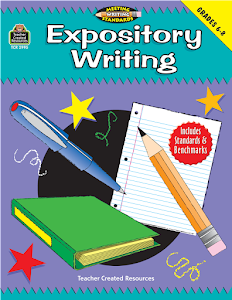LEARNING ABOUT THE DIFFERENT TYPES OF WRITING!!!
Genre: Expository
By: Shaniel Liburd-Bryan
First, I have to start with my misconception. I have always learned that expositions always have an opening sentence or thesis statement and because this is all I knew I sadly passed that on to my students. My preparations and consultation with my lecturer taught me that not all expository pieces have thesis statements.
I'm sure reading this you are puzzled. I sure was!
I never really observed that the only time an expository piece has a thesis statement was if it is written as an essay. Which led my mind to wonder and realize that it was indeed true. For example, a piece that tells you how to make a cake for instance is an expository, but when it is displayed online you receive the recipe and steps in numbered or bullet form. That was my ohhh!!! moment. It was something worth noting when I reentered the classroom.
I also learned more ways to utilize the traits and processes in the different types of writing especially exposition. Researching enabled me to find out more about exposition and come across so many different fun activities that can make lessons more engaging and worthwhile like the few displayed below.
Fishing for Errors
Reading Festival
Musical Papers
Pair Writing
During our workshop sessions, we were able to use some of the activities found which made the session very interactive and fun. Some activities were Minute to Write, Demonstrate it (with a twist), and spot the errors.
Try these activities and more in your next class and let me know what you think!
Until next time........






I can totally relate to your realization about not all expositions have a thesis statements. It was a shock for me too when I learned that not all expositions need a thesis statement. The examples provided by the lecturer made me realize I had it wrong all these years. It just shows how continuous learning can be. Looking forward to reading more!
ReplyDeleteGood afternoon Shaniel, I equally was taken aback about the Thesis statement. I never recognized that it did not need the use it unless the piece is an essay. The presentation provide much clarity in that regard including the use strategies use to assist the teaching expository writing to students. Such as demonstrate it, my favorite to be really honest, because it shows students that if they do not write with clear steps, the reader can misinterpret what was intended to be done. Therefore, this is an nudge to students to apply themselves to the writing of clear and concise steps for writing
ReplyDeleteShaniel, your blog post on exposition is really refreshing. It's great that you acknowledge and reflect on your own misconceptions, leading to a deeper understanding of expository writing. The realization that not all expository pieces require a thesis statement, especially in formats like recipes, is indeed an "ohhh!!!" moment worth sharing. I appreciate how you've shared various engaging activities that can be implemented during class sessions, making learning interactive and enjoyable like Fishing for Errors, Reading Festival, Musical Papers, and Pair Writing. Encouraging others to try these activities in their classes adds a collaborative touch to your post. Looking forward to your next insights!
ReplyDelete